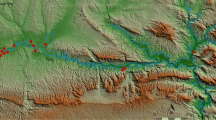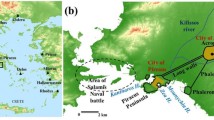Abstract
The development of the ancient city of Gadara is strongly associated with its usable water resources: the city area could become more inhabitable only if sufficient water was available. Water resources were crucial for the city, which was located in the semiarid climate zone to the north of Jordan. During the city’s founding era in the Hellenistic period, this need for water could be met by collecting rainwater in cisterns. However, more water was needed for the continuing development of the city. This demand could only be achieved by connecting the city to springs located on higher grounds. For this purpose, a 30-km-long aqueduct called the Qanāt Turāb was built, and water was distributed through a complex system of tunnels in the inner city area. During the Roman Empire, the city became famous and experienced economic prosperity through trade. A new aqueduct, the 153-km-long Qanāt Fir’aun, was built to satisfy its extravagant need for water. This water supply system was used even after the fall of the Roman Empire, until a major earthquake in the eighth century AD inflicted severe damages in Gadara. Following this destruction, the Hellenistic cisterns once again became important for the water supply of the now-detached settlements. This study analyses Gadara’s water supply system and its hydraulics during the above-mentioned time periods—a 1000-year stretch—of the city’s history. The study unravels the manner in which water demand, water resources and technologies of the ancient city developed over time. Literature review and field data, surveyed between 2004 and 2011, form the basis for the analyses. Special attention is paid to the Roman period, when the water supply functioned through aqueducts. By analysing the different construction phases of the aqueduct tunnels and their interaction with the architecture, it is possible to reconstruct the development of the tunnel system and subsequently date it. The inner city’s water supply system of this period has been well preserved, which makes it possible to reconstruct the hydraulics. This study used the one-dimensional hydraulic software MIKE 11 to determine the water fluxes to the different city areas.













Similar content being viewed by others
References
Abert B, Keilholz P (2008) Elemente der Wasserversorgung in Gadara/Jordanien. Unpublished study project at the University of Applied Science, Lübeck
Al Karaimeh, S. (2012) Roman law and archaeological evidence on water management. In: Żuchowska M (ed) The archaeology of water supply. BAR International Series 2414, Archaeopress, Oxford, pp 41–48
Al-Daire M (2004) Water management in Trans-Jordan Byzantine architecture with respect to excavated monuments in the city of Gadara/Umm Qais. Men of dikes and canals: the archaeology of water in the middle east, pp 219–230
Ambraseys N (2009) Earthquakes in the mediterranean and middle east. Cambridge University Press, London
Bol PC, Hoffmann A, Weber T (1990) Gadara in der Dekapolis, Deutsche Ausgrabung bei Umm Qais in Nordjordanien 1986 bis 1988. Archäologischer Anzeiger: 193–266
Böser W (1997) Vermessung eines antiken Stollensystems in Gadara/Jordanien. Karlsruher Geowissenschaftliche Schriften, Reihe B: Geodätische, photogrammetrische und kartographische Berichte II. Bd. 3:101–116
Brinker W (1990) Wasserspeicherung in Zisternen: Ein Beitrag zur Frage der Wasserversorgung früher Städte. Mitteilungen des Leichtweis-Instituts für Wasserbau der TU Braunschweig 109
Bührig C (2009) Das Theater-Tempel-Areal von Gadara/Umm Qais, Struktureller Wandel eines urbanen Raums. Zeitschrift für Orient-Archäologie 2: 162–207
Bührig C, Hartl-Reiter C (2006) Topografischer Bestandsplan von Gadara/Umm Qais, Deutsches Archäologisches Institut–Orient Abteilung, Berlin
DHI (2014) MIKE 11—user manual. Hørsholm
Döring M (2010) Qanat Fir’ūn—documentation of the 100 kilometres aqueduct-tunnel in northern Jordan. Annu Dep Antiq Jordan 53:153–165
Döring M (2012) Wasser für die Dekapolis-Jordanisches Bergland birgt längsten bisher bekannten Aquädukttunnel. In: Klimscha F, Eichmann R, Schuler C, Fahlbusch H (ed) Wasserwirtschaftliche Innovationen im archäologischen Kontext Band, vol 5. pp 225–244
Döring M (2016) Wasser für die Dekapolis. Schriften der Deutschen Wasserhistorischen Gesellschaft e.V.: S. 12
Dreves A (2011) Datierungsergebnisse der Proben KIA 44028–44034. Unpublished report at the Leibnitz Labor für Altersbestimmung und Isotopenforschung. Christian-Albrechts-Universität Kiel
Fahlbusch H (1982) Vergleich antiker griechischer und römischer Wasserversorgungsanlagen. Mitteilungen des Leichtweis-Instituts für Wasserbau der TU Braunschweig 73
Fensterbusch C (2008) Vitruv—Zehn Bücher über Architektur. German translation with comments. Wissenschaftliche Buchgesellschaft, Darmstadt
Hansen R (1983) Water and waste in Imperial Rome. J Am Water Resour Assoc 19(2):263–269
Hoffmann A (2002) Topographie und Stadtgeschichte von Gadara/Umm Qais. In: Hoffmann A, Kerner S (ed) Gadara–Gerasa und die Dekapolis, Mainz, pp 98–124
Keilholz P (2014) The ancient cisterns of Hellenistic Gadara/Umm Qais (Jordan). In: Schäfer T, Schön F, Gerdes A, Heinrichs J (ed) Antike und moderne Wasserspeicherung. Tübinger Archäologische Forschungen, vol 12. pp 27–36
Kerner S (2002) Gadara–Schwarzweiße Stadt zwischen Ajlun und Golan. In: Hoffmann A, Kerner S (ed) Gadara–Gerasa und die Dekapolis. Mainz, pp 125–136
Kerner S (2004) The water systems in Gadara and other decapolis cities of northern Jordan. Men of dikes and canals: the archaeology of water in the middle east, pp 187–202
Krebs H, Michaelis D (1994) Hydraulisch-wasserbautechnische Untersuchungen im Zusammenhang mit dem antiken Wasserversorgungssystem von Gadara (Umm Qais). Unpublished study project at Technical University, Braunschweig
Krezschmer F (1961) Römische Wasserhähne. Jahrbuch der Schweizerischen Gesellschaft für Urgeschichte 48: 50–62
Margane A, Hobler M, Subah A (1997) Groundwater resources of northern Jordan. Special report no. 3. Mapping of groundwater vulnerability and hazards to groundwater in the Irbid area
Migowski C, Agnon A, Bookman R, Negendank J, Stein M (2004) Recurrence pattern of Holocene earthquakes along the Dead Sea transform revealed by varve-counting and radiocarbon dating of lacustine sediments. Earth Planet Sci Lett 222:301–314
Nielsen I, Andersen FG, Holm-Nielsen S (1993) Die byzantinischen Thermen, Gadara-Umm Qēs III. Abhandlungen des deutschen Palästinavereins
Obeidat M, Ahmad F, Hamouri N, Massadeh A, Athamneh F (2008) Assessment of nitrate contamination of karst springs, Bani Kanana, northern Jordan. Rev Mex de Cienc Geol 252:426–437
Ohlig C (2004) Ein castellum aquae ist wie jedes andere… Schriften der Deutschen Wasserhistorischen Gesellschaft e.V.: 133–182
Posselt E (1999) Gadara-Keramik. Entwicklung einer Typologie: Unpublished master’s thesis at the Seminar für Klassische Archäologie. FU Berlin
Reed J (2002) Archaeology and the Galilean Jesus: a re-examination of the evidence. Harrisburg
Zenz F (2006) Das Nymphäum von Gadara/Umm Qais in Jordanien. Proceedings of the 12th international congress on the history of water management and hydraulic engineering in the mediterranean region/Ephesus 2004, vol II. pp 409–414
Acknowledgments
This research is the result of nine survey trips between 2004 and 2011 carried out as part of or in cooperation with the following research projects: Excavations, surveys and analyses of water distributor II, cisterns, basalt pipe and the water outlet of the North Theatre were conducted between 2005 and 2007 within the framework of the project ‘Zur urbanistischen und kulturhistorischen Entwicklung der antiken Stadt Gadara, dem modernen Umm Qais’. The project was a joint venture between the German Archaeological Institute (DAI)–Oriental department and the Staatliche Museen zu Berlin, with the financial contribution (field trip 2007) of the German Water Historical Society (DwhG). The project leaders were Dr Bührig and Prof Dr Schauerte. Prof Dr Fahlbusch from the University of Applied Science, Lübeck, supervised this project. Surveys along the Qanāt Turāb and Qanāt Fir’aun systems in the inner and outer city areas were conducted by the research projects of the Deutsche Forschungsgemeinschaft (DFG) during the years 2005–2011. The project ‘Wasser für die Dekapolis. Römische Fernwasserleitung in Jordanien’ was led by Prof Dr Döring. All involved researchers, students and sponsors have contributed to the success of this research work and deserve special recognition.
Author information
Authors and Affiliations
Corresponding author
Rights and permissions
About this article
Cite this article
Keilholz, P. Water supply and distribution in the ancient Decapolis city of Gadara. Water Hist 9, 147–168 (2017). https://doi.org/10.1007/s12685-016-0178-6
Received:
Accepted:
Published:
Issue Date:
DOI: https://doi.org/10.1007/s12685-016-0178-6




